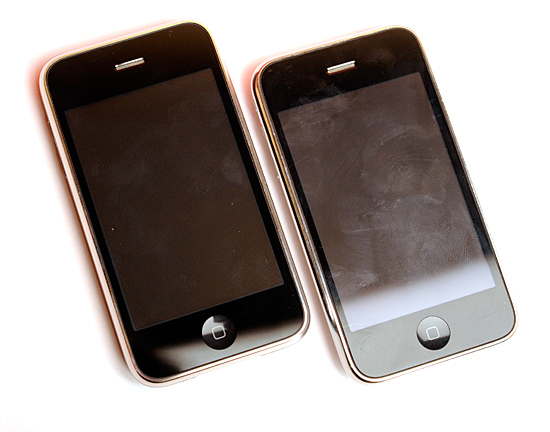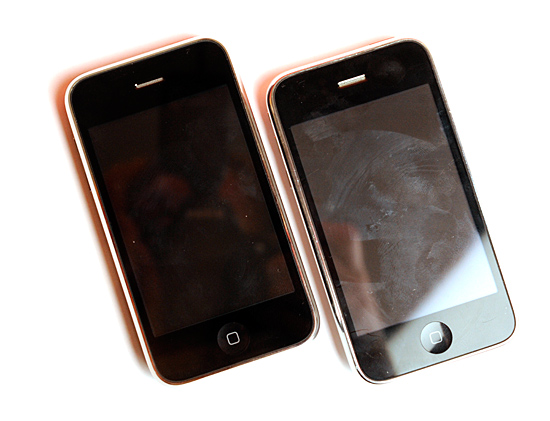Understanding the iPhone 3GS
by Anand Lal Shimpi on July 7, 2009 12:00 AM EST- Posted in
- Smartphones
- Mobile
The Screen
There’s no increase in resolution and thanks to the iPhone OS 3.0 update, the automatic backlight is even more aggressive in making the 3GS as dim as possible - so why even bother having a section in the review called The Screen?
While not as dense as the Pre’s screen, the iPhone 3GS continues to have one of the best touchscreens on the market. Sure you get no feedback from your touches, but honestly, that’s something most seem to be able to get over.
There is one small improvement to the 3GS’ screen over the 3G. The new phone comes with a new oleophobic coating on the screen.
First a compass and now an oleophobic screen? Despite what you may think, this feature is actually pretty useful. Fingerprints and smudges still get on the new iPhone but they easily come off and they definitely aren't as present as on the older models.

iPhone 3GS (left) vs. iPhone 3G (right)

iPhone 3G (left) vs. iPhone 3GS (right)

iPhone 3GS (left) vs. iPhone 3G (right)
One side effect of the oleophobic coating is an increase in resistance on the surface of the screen. Your finger doesn't glide as smoothly over the new screen as it did over the old one. It’s a bit ironic actually. Newly washed hands will feel more resistance than hands with a bit of oil on them, yet the fingerprints aren’t as prevalent on the 3GS as they were on the 3G.

iPhone 3GS (left) vs. iPhone 3G (right) after being wiped down
The new screen is nice - but I still want an oleophobic coating on the back of the iPhone 3GS. The black plastic especially shows finger prints and general nastiness infinitely worse than the original metal iPhone.










60 Comments
View All Comments
MrJim - Wednesday, July 8, 2009 - link
Why no mention of the heat issues?ViRGE - Wednesday, July 8, 2009 - link
Anand, if you haven't already, jailbreak the 3GS and grab SysInfoPlus from Cydia. It may be able to tell you the clock speed of the 3GS's ARM, although to what extent I'm not sure since it hasn't been specifically programmed for the A8.ltcommanderdata - Wednesday, July 8, 2009 - link
I don't suppose that program can also tell the GPU clock speed too?I always thought that the MBX work at bus speed, ie. 103MHz for the iPhone/3G and 133MHz for the 2nd Gen iPod Touch instead of the 60Mhz that Anand has speculated. Assuming the iPhone 3G S has a 150MHz bus speed, the SGX could run at 150MHz which is a reasonable compromise between Anand's 100MHz and 200MHz estimates.
fyleow - Wednesday, July 8, 2009 - link
How useful is the new GPU? The iPhone's performance has come a long way from the first generation but I don't see developers taking full advantage of the jump. If you bump up the graphics of your game it might run smoothly on the 3GS but end up lagging on the 1st gen iPhone.The increase in load times and battery life is much welcomed, but when do we get to see some apps that take advantage of the upgraded hardware in other more interesting ways? I can see a resolution increase as being one way to do that. The game would look better on a higher resolution screen but performance wouldn't suffer on the older models because the lower resolution would place less demand on the hardware.
2010 will be an interesting year. There should be a bigger upgrade to the iPhone, most likely a resolution bump and a significantly modified OS that supports background tasks. Apple has been keeping all the devices on the iPhone platform on feature parity so far with the OS upgrades (minus obvious limitations due to hardware differences). It would be interesting to see how they handle the switch and the resulting two classes of phones that come from it (i.e. old "legacy" iPhones/Touch vs new iPhones/Touch).
ltcommanderdata - Wednesday, July 8, 2009 - link
You're right that it's difficult to take full advantage of the SGX without writing a separate dedicated code path for it and one for the MBX. However, there are simpler ways to take advantage of the iPhone 3G S power without writing 2 separate code paths. For example, you can scale draw distance based on hardware. Firemint demonstrated the iPhone 3G S accelerating 40 cars in Real Racing compared to 6 in the iPhone 3G, so the potential for better scalable AI is there. For a RPG, perhaps having more NPCs walking around to make the environment more lifelike. This can all be done using existing OpenGL ES 1.1 code playable on all iPhones/Touches, optimizing for each device, without making older iPhone users feel like they are playing some Lite version of the game as implementing shaders and HDR using OpenGL ES 2.0 in the iPhone 3G S might do.I believe the reluctance of Apple to change the resolution is that it could break the interface layout for existing apps and/or make things ugly if apps haven't used vector graphics. It would have been nice if they had enforced resolution independence early on, but I don't believe they did. Resolution independence is also what is needed for Apple to introduce an iPhone nano with a smaller screen and presumably smaller resolution.
smallpot - Wednesday, July 8, 2009 - link
Thanks for the article Anand. Your long-form articles are the reason Anandtech is my number one tech website. I'm thinking of articles such as this, your articles on SSD performance, and the long-form story behind the RV770. After reading such articles, I really feel like I've learned something, rather than just had performance metrics thrown at me without context.Baron Fel - Tuesday, July 7, 2009 - link
Interesting article.As far as portable gaming goes, the Ipod Touch/iPhone/Zune HD dont have a chance against the DS or even the PSP. The software support just isnt there.
PSP hardware runs circles around the DS, so why is the DS killing it in sales? Good games.
and are we getting more SSD articles anytime soon? I think thats what we want to see :D
ltcommanderdata - Tuesday, July 7, 2009 - link
Given all the media attention about discoloration and possible heat issues with the iPhone 3G S, I was wondering if you could comment on your experience in this area. Do you think it's a real concern or just stories popularized to generate page hits as Apple related stories tend to do? The latest reports on discoloration indicate that it might actually be from a reaction with some third-party cases that may be reversed by cleaning with alcohol.Similarly, there have been lower-key reports of build quality issues with the Palm Pre having a wobbly screen from it's slide-out keyboard. Has this been a major issue for you and do you think it'll be an issue over time?
Anand Lal Shimpi - Tuesday, July 7, 2009 - link
I haven't seen anything to indicate heat as being a bigger concern with the 3GS. It's a new processor so there's bound to be some bad chips out there, but I wouldn't be too concerned.The build quality on the Pre did bother me. It's something that I think bothered me more because of my experience with the iPhone. The screen was a bit wobbly and overall the device just didn't feel as well put together. Part of it is because of the slide out keyboard, but part of it has to be cost/experience related. I think you'd get used to it over time, but if you then held an iPhone you'd quickly grow tired of the build quality issues once again :)
Take care,
Anand
tomoyo - Tuesday, July 7, 2009 - link
Btw Anand, the chart for number of stages in the cpus shows the Iphone 3GS as 8 stage instead of 13.